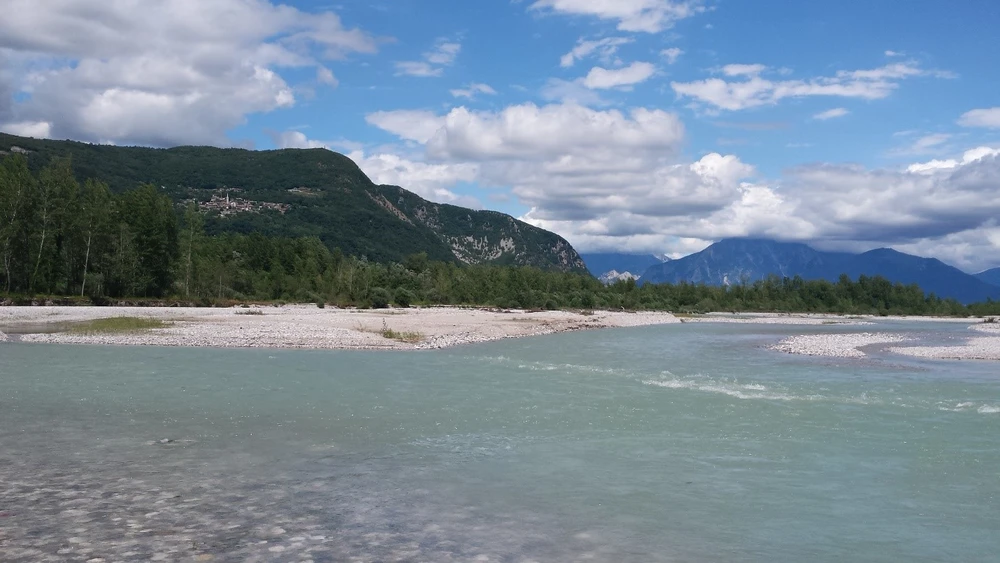
Dr. Alexander Sukhodolov and his research team are working on a project titled “Transport and Mixing at River Confluences”, funded by the Deutsche Forschungsgemeinschaft (DFG). This work aims to improve our knowledge of mixing and transport of substances at and immediately downstream of river confluences and to provide insight into factors that control mixing processes. Alex’s work is a companion to Dr. Bruce Rhoads’ project (together with colleague Dr. George Constantinescu at University of Iowa) titled “Collaborative Research: Mixing at Stream and River Confluences”, funded by the National Science Foundation (NSF). This research also focuses on understanding the mechanisms that control mixing of water and transported materials at and downstream of confluences and the generation of large-scale turbulent structures at confluences. Bruce and Alex have collaborated on numerous studies of river confluences in the past (Rhoads and Sukhodolov, 2001; 2004; 2008; Sukhodolov and Rhoads, 2001).
After some unfortunate travel issues, Bruce and I arrived in Italy and met Alex in the small town of Flagogna, in the foothills of the Italian Alps about an hour northeast of Venice. We traveled to the field site (46.204315 N, 12.971066 E) on the Tagliamento River, a classic braided river. Braided rivers are characteristic of mountain regions – they are composed of numerous short-lived channels surrounded by exposed sediment (bars) and vegetated floodplain, they have a relatively steep gradient, have highly variable discharge (often varying seasonally from snowmelt input), generally carry coarse sediment, and have erodible banks. These qualities make braided rivers wide and shallow and cause the pattern of individual “braids” of water and exposed bars to change rapidly in response to floods. The Tagliamento is no exception.
Alex and his research team have set up a model confluence in a groundwater-fed side channel of the Tagliamento. Since the reach is fed only by groundwater at low flow (such as in the summer when we visited) the flow of water is remarkably constant and therefore more suitable for research purposes. Alex and his team have built an impressive confluence out of gabions, or wire “cages” filled with rocks. These gabions deflect flow into the model confluence and, together with a series of wooden gates, can be used to control the amount of water entering each tributary of the confluence.
An array of five acoustic instruments measure velocity in the near tributary. Flow is from left to right. Alex and his team measure velocity at a dense vertical and lateral resolution in order to assess how the specific flow conditions, such as confluence angle and ratio of velocity between the tributaries, affects velocity and mixing within and downstream of the confluence. Additional experiments at this study site include flow visualization using dye injected to one or both of the upstream tributaries as well as assessments of how placing modeled vegetation within the confluence affects flow and mixing patterns.
We helped Alex and his team collect data for this project while discussing current and future collaborative work. In addition, we visited the sites of potential future confluence studies (Figure 3) and past confluence studies (Figure 4). Overall, it was a productive trip! Working with Alex helped us clarify the goals and processes involved in our own projects. It is very helpful being able to have another critical voice to help us get the most out of our own mixing project, while seeing another research group’s methods in action. We look forward to hosting Alex in Champaign-Urbana next summer and continuing our collaborative research!
References:
Rhoads, B. L., and Sukhodolov, A.N., 2001. Field investigation of three-dimensional flow structure at stream confluences: 1. Thermal mixing and time-averaged velocities. Water Resources Research. vol. 37, pp. 2393–2410. doi:10.1029/2001WR000316.
Rhoads, B. L., and Sukhodolov, A.N., 2004. Spatial and temporal structure of shear layer turbulence at a stream confluence. Water Resources Research. vol. 40. W06304. doi:10.1029/2003WR002811.
Rhoads, B. L., and Sukhodolov, A.N., 2008. Lateral momentum flux and the spatial evolution of flow within a confluence mixing interface. Water Resources Research. vol. 44. W08440. doi:10.1029/2007WR006634.
Sukhodolov, A. N. 2015. Field-based research in fluvial hydraulics: potential, paradigms and challenges. Journal of Hydraulic Research. vol. 53.1, pp. 1-19. doi:10.1080/00221686.2015.1012126.
Sukhodolov, A. N., and Rhoads, B. L., 2001. Field investigation of three-dimensional flow structure at stream confluences: 2. Turbulence, Water Resources Research. vol. 37, pp. 2411–2424. doi:10.1029/2001WR000317.